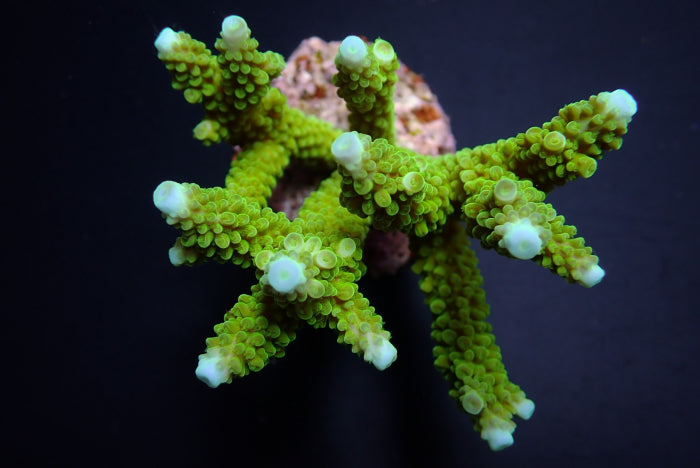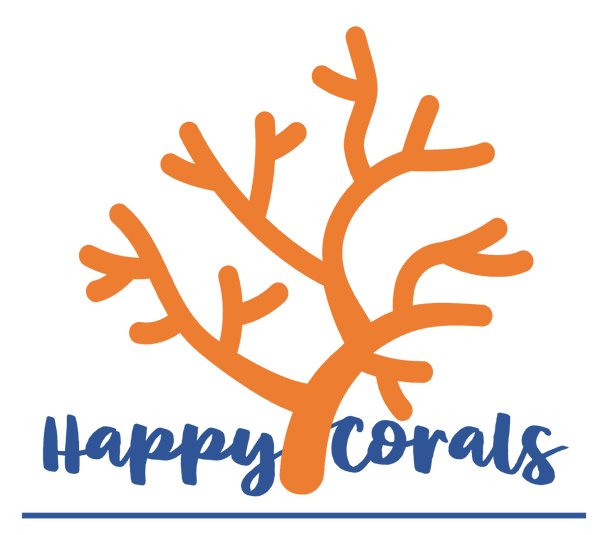Coralreef Store
Acropora formosa (Blue tip)
Acropora formosa (Blue tip)
Couldn't load pickup availability
- Indo-Pacific
- High Care Level
- For Advanced Hobbyists
- High Placement in Reef Tank
Acropora formosa, also known as the Blue Tip Acropora, is a visually striking species of branching stony coral found in the Indo-Pacific region. This coral is admired for its vibrant blue tips that contrast beautifully with the rest of its branches, which can vary in color from green to light brown, depending on environmental conditions. It is known for its fast growth and branching structure, making it a dynamic addition to any reef tank. However, Acropora formosa requires specific care and stable water conditions, so it is best suited for advanced hobbyists who can maintain the necessary parameters and provide the appropriate environment.
Placement in the Tank
Acropora formosa thrives under strong lighting, with an ideal light intensity of 250-350 PAR. It should be placed in the upper sections of the tank, where it can receive intense light, similar to its natural habitat in shallow reef environments. Additionally, Acropora formosa requires strong water flow to facilitate nutrient uptake and help remove waste, which promotes healthy growth. Proper water movement is crucial to ensure the coral receives adequate nutrients and maintains a clean surface.
Water Parameters
Maintaining optimal water parameters is essential for the health of Acropora formosa. The recommended water conditions include:
- Temperature: 24°C to 28°C (75°F to 82°F), with a stable temperature of 26°C (79°F) being ideal.
- Salinity: 1.023–1.025 specific gravity (SG), with 1.024 being optimal.
- pH: 8.0 to 8.4, with an ideal pH of 8.2.
- Alkalinity (dKH): 8-12 dKH, with 9-10 dKH being ideal for healthy growth.
- Calcium: 400-450 ppm to support robust skeletal development.
- Magnesium: 1250-1350 ppm.
- Nitrate: Less than 5 ppm, as high nitrate levels can harm coral health.
- Phosphate: Below 0.03 ppm to prevent unwanted algae growth and nutrient competition.
Feeding
While Acropora formosa relies heavily on its zooxanthellae algae for photosynthesis, it can benefit from supplemental feeding. Providing zooplankton, phytoplankton, or liquid coral foods on occasion will help enhance its growth and health, especially in tanks with limited planktonic life. Feeding should be done sparingly to avoid water quality issues, and it is important not to overfeed the coral.
Maintenance and Care
Proper maintenance is key to ensuring the health of Acropora formosa:
- Water Changes: Perform regular water changes (10-15% weekly) to maintain stable water parameters and reduce harmful substances.
- Water Parameter Monitoring: Regularly check temperature, pH, alkalinity, calcium, and phosphate levels to ensure optimal conditions.
- Pruning: Acropora formosa can grow quite rapidly, so it may require occasional fragging if it becomes too large or starts to crowd other corals.
- Pest Control: Keep an eye out for pests such as red bugs, flatworms, and Aiptasia. Immediate action should be taken if pests are detected, as they can damage the coral.
Compatibility
Acropora formosa is an aggressive coral due to its long, stinging sweeper tentacles, which can harm neighboring corals. It is best placed away from soft corals and LPS species, as they can be damaged by its aggression. Acropora formosa can be housed with other non-aggressive SPS species if they are given enough space to grow and thrive without competition.
Conclusion
Acropora formosa (Blue Tip) is a beautiful and vibrant coral species that adds dynamic color and structure to any reef tank. Its blue tips and fast-growing nature make it a captivating centerpiece, but its high care requirements make it suitable for advanced hobbyists. By providing strong lighting, strong water flow, and stable water conditions, this coral can thrive and become a stunning addition to your reef aquarium.
Share


